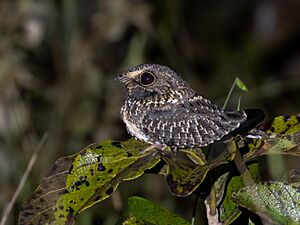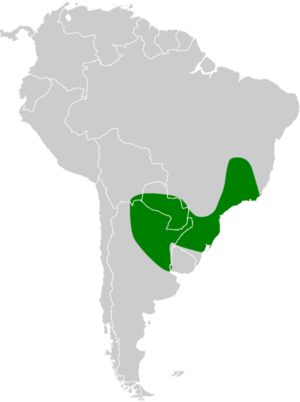Sickle-winged nightjar facts for kids
Quick facts for kids Sickle-winged nightjar |
|
|---|---|
 |
|
| Conservation status | |
| Scientific classification | |
| Genus: |
Eleothreptus
|
| Species: |
anomalus
|
 |
|
| Synonyms | |
|
|
The sickle-winged nightjar (Eleothreptus anomalus) is a special bird known for its unique wing shape. It belongs to a group of birds called nightjars. You can find this bird in countries like Argentina, Brazil, and Paraguay. Scientists think it might also live in Uruguay.
Contents
About the Sickle-Winged Nightjar
This bird gets its name from its cool, curved wings that look a bit like a farmer's sickle. It's part of the Caprimulgidae family, which includes all nightjars.
How Scientists Name This Bird
The sickle-winged nightjar was first described by a scientist named John Gould in 1838. He gave it the name Amblypterus anomalus. Later, it was grouped with other birds in the Caprimulgus family. Since the early 2010s, scientists have placed it in its own special group called Eleothreptus. It shares this group with only one other bird, the white-winged nightjar. The sickle-winged nightjar is the only one of its exact kind, meaning it has no subspecies.
What Does This Bird Look Like?
The sickle-winged nightjar is about 18 to 20 centimeters (7 to 8 inches) long. One male bird weighed about 43.7 grams (1.5 ounces).
The male bird has grayish-brown feathers on its back. These feathers have darker brown spots. Its wings are very special. They have a hooked, "sickle" shape because of how its main flight feathers are formed. The wings are mostly grayish-brown with blackish-brown, cinnamon, and white marks.
The male's chin is a light yellowish-white with brown stripes. Its throat is brownish with a hint of cinnamon and more brown stripes. The chest is brown with light spots and streaks. Its belly and sides are pale yellowish-white with brown stripes.
Female sickle-winged nightjars are browner than the males. They do not have the special "sickle" shaped wings. Their spots and stripes are also a bit different. Young birds look similar to the females. They have a cinnamon color on their upper parts.
Where Does This Bird Live?
Scientists are still learning exactly where the sickle-winged nightjar lives. It has been seen in northeastern Argentina, southern Paraguay, and southern Brazil. People think it might also live in Uruguay, but there are no official records yet. Some sightings have been made further north in Brazil than its known range.
Most scientists believe these birds stay in their home areas all year. However, some think that birds from Argentina might fly north after the breeding season.
How the Sickle-Winged Nightjar Behaves
Feeding Habits
The sickle-winged nightjar is active during twilight (when the sun is setting or rising) and at night. It hunts for food by flying up from the ground to catch insects. It might also catch insects while flying low and steadily.
Between hunts, it likes to sit on roads or trails. It also perches on low tree branches or wire fences. When it flies, it uses slow, fluttering wing beats and then glides. We know it eats insects, but scientists are still learning more about its exact diet.
Reproduction and Life Cycle
The breeding season for the sickle-winged nightjar seems to be from August to November, or even later. This is based on when adult birds are ready to breed, and when eggs and young birds are seen. Like other nightjars, it is believed to lay its eggs directly on the ground. It does not build a nest.
Bird Calls and Songs
People describe the sickle-winged nightjar's song in different ways. Some say it sounds like a series of soft "chip," "tchup," or "tchut" notes. Others describe it as "chirping, cricket-like sounds." Another description is a soft, single "tick." When it flies, it sometimes makes a harsh, nasal "gzee gzee" call.
Status of the Sickle-Winged Nightjar
The IUCN (International Union for Conservation of Nature) has listed the sickle-winged nightjar as a vulnerable species. This means its population is quite small and is quickly shrinking. This is mainly happening because its natural home is being lost or damaged.


